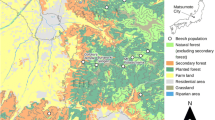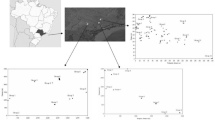Summary
Gene flow was investigated in a natural population of Lotus corniculatus L. (Fabaceae) using a combination of pollen and seed dispersal studies and a recombinant DNA technique. The population is spatially heterogeneous and grows with Empetrum nigrum. L. corniculatus is pollinated by the pollen-collecting bumblebee Bombus lapidarius L. Most pollinator flights occurred within patches, as bees usually visit nearest-neighbour plants, show no marked directionality, and forage mostly within patches. Gene flow by seeds is also limited, reinforcing the pattern of gene flow within patches. However, 2.6% of pollinator flights are between patches and considerable pollen carryover also occurs. Thus, gene flow between patches is potentially sufficient to retard or prevent genetic differentiation in spite of the patchy sub-structuring of the population. A sub-set of the population was analysed for restriction fragment length polymorphisms (RFLPs) to document the actual gene flow pattern of the population. The DNA analysis revealed significant levels of genetic differentiation between the patches. The level of gene flow that can be inferred from the distribution of genetic variation is surprisingly restricted, as compared to gene flow inferred from pollinator behaviour, and emphasizes that stochastic processes like genetic drift and founder effects may have a strong impact on the prevailing genetic structure.
Similar content being viewed by others

References
Beattie A (1978) Plant-animal interactions affecting gene flow in Viola. In: AJ Richards (ed) The pollination of flowers by insects, Academic Press London, pp 151–164
Brødsgaard B, Rasmussen IR (1990) Gene flow in the species Lotus corniculatus L. M.Sc. thesis, University of Copenhagen, Denmark
Böcher TW (1952) Vegetationsudvikling i forhold til marin akkumulation. I. Korshage ved indløbet til Isefjord. English summary: Plant succession in relation to marine accumulation. I. The point Korshage at the entrance to Isefjord (Seeland). Bot Tidsskr 49: 1–32
Campbell DR, Waser NM (1989) Variation in pollen flow within and among populations of Ipomopsis aggregata. Evolution 43: 1444–1455
Dreisig H (1985) Movement patterns of a clear-wing hawkmoth, Hemaris fuciformis, foraging at red catchfly, Viscaria vulgaris. Oecologia 67: 360–366
Ellstrand NC, Devlin B, Marshall DL (1989) Gene flow by pollen into small populations: Data from experimental and natural stands of wild radish. Proc Natl Acad Sci USA 86: 9044–9047
Galen C, Plowright RC (1985) The effect of nectar level and flower development on pollen carryover in inflorescences of fireweed (Epilobium angustifolium) (Onagraceae). Can Bot 63: 488–491
Handel SN (1982) Dynamics of gene flow in an experimental population of Cucumis melo (Cucurbitaceae). Am J Bot 69: 1538–1546
Heinrich B (1979) Resource heterogeneity and patterns of movement in foraging bumblebees. Oecologia 40: 235–245
Helentjaris T, King G, Slocum M, Siedenstrand C, Wegman S (1985) Restriction fragment polymorphisms as probes for plant diversity and their development as tools for applied plant breeding. Plant Mol Biol 5: 109–118
Hodges CM, Miller RB (1981) Pollinator flight directionality and the assessment of pollen returns. Oecologia 50: 376–379
Jofuku KD, Goldberg RB (1988) Analysis of plant gene structure In: Shaw CH (ed) Plant Molecular Biology — A practical approach. IRL Press, Oxford, pp 37–51
Jones DA, Turkington R (1986) Biological flora of the British Isles. Lotus corniculatus L. J Ecol 74: 1185–1212
Learn GH, Schaal BA (1987) Population subdivision for ribosomal DNA repeat variants in Clematis fremontii. Evolution 41: 433–438
Levin DA (1978) Pollinator behaviour and the breeding structure of plant populations. In: Richards AJ (ed) The pollination of flowers by insects. Academic Press, London, pp 133–150
Levin DA (1981) Dispersal versus gene flow in plants. Ann Mo Bot Gard 68: 233–253
Levin DA (1983) Plant parentage: An alternate view of the breeding structure of populations. In: King CE, Dawson PS (eds) Population biology — Retrospect and prospect. Columbia University Press, New York, pp 171–188
Levin DA (1984) Immigration in plants: an exercise in the subjunctive. In: Dirzo R, Sarukhan J (eds), Perspectives on plant population ecology. Sinauer, Sunderland, MA, pp 242–260
Levin DA (1988) Local differentiation and the breeding structure of plant populations. In: Gottlieb LD, Jain SK (eds) Plant evolutionary biology. Chapman and Hall, London, pp 305–329
Levin DA, Kerster HW (1968) Local gene dispersal in Phlox. Evolution 22: 130–139
Levin DA, Kerster HW (1969a) Density-dependent gene dispersal in Liatris. Am Nat 103: 61–74
Levin DA, Kerster HW (1969b) The dependence of bee-mediated pollen and gene dispersal upon plant density. Evolution 23: 560–571
Levin D, Kerster HW, Niedzlek M (1971) Pollinator flight directionality and its effect on pollen flow Evolution 25: 113–118
Mead DA, Szczesna-Skorupa E, Kemper B (1986) Single-stranded DNA “blue” T7 promotor plasmids: a versatile tandem promoter system for cloning and protein engineering. Protein Engineering 1(1): 67–74
Milberg P (1990) Hur länge kan et frö leva? English summary: What is the maximum longevity of seeds? Sven Bot Tidskr 84: 323–352
Nevo E, Beiles A, Kaplan D, Golenberg EM, Olsvig-Whittaker L, Naveh Z (1986) Natural selection of allozyme polymorphisms: A microsite test revealing ecological genetic differentiation in wild barley. Evolution 40: 13–20
Nybom II, Schaal BA (1990) DNA “fingerprints’ reveal genotype distributions in natural populations of blackberries and raspberries (Rubus, Rosaceae). Am J Bot 77: 883–888
Olesen JM, Warncke E (1989) Temporal changes in pollen flow and neighbourhood structure in a population of Saxifraga hirculus L. Oecologia 79: 205–211
Plowright RC, Galen C (1985) Landmarks or obstacles: the effect of spatial heterogeneity on bumble bee foraging behaviour. Oikos 44: 459–464
Pyke G (1978) Optimal foraging: Movement patterns of bumble-bees between inflorescences. Theor Popul Biol 13: 72–98
Rogers SO, Bendich AJ (1988) Extraction of DNA from plant tissues: Plant molecular biology manual A6: 1–10 Kluwer Academic Publishers, Dordrecht
Sambrook J, Fritsch EF, Maniatis T (1989) Molecular cloning — A Laboratory Manual. Cold Spring Harbor Laboratory Press, New York
Schaal BA (1978) Density dependent foraging on Liatris pycnostachya. Evolution 32: 452–454
Schaal BA (1980) Measurement of gene flow in Lupinus texensis. Nature 284: 450–451
Schaal BA, Leverich WJ, Nieto-Soleto J (1987) Ribosomal DNA variation in the native plant Phlox divaricata. Mol Biol Evol 4: 611–621
Schmitt J (1980) Pollinator foraging behaviour and gene dispersal in Senecio (Compositae). Evolution 34: 934–943
Schmitt J (1983) Density-dependent pollinator foraging, flowering phenology, and temporal pollen dispersal patterns in Linanthus bicolor. Evolution 37: 1247–1257
Sih A, Baltus M-S (1987) Patch size, pollinator behaviour, and pollinator limitation in catnip. Ecology 68: 1679–1690
Slatkin M (1987) Gene flow and the geographic structure of natural populations. Science 236: 787–792
Smyth CA, Hamrick JL (1987) Realized gene flow via pollen in artifical populations of musk thistle, Carduus nutans L. Evolution 41: 613–619
Sokal RS, Rohl FJ (1981) Biometry, 2nd edn, W.H. Freeman and Company, New York
Sowig P (1989) Effect of flowering plants' patch size on species composition of pollinator communities, foraging strategies, and resource partitioning in bumblebees (Hymenoptera: Apidae). Oecologia 78: 550–558
Stamp NE, Lucas JR (1983) Ecological correlates of explosive seed dispersal. Oecologia 59: 272–278
Svensson L (1985) An estimate of pollen carryover by ants in a natural population of Scleranthus perennis L. (Caryophyllaceae). Oecologia 66: 373–377
Thomson JD, Plowright RC (1980) Pollen carryover, nectar rewards, and pollinator behaviour with special reference to Diervilla lonicera. Oecologia 46: 68–74
Thomson JD, Thomson BA (1989) Dispersal of Erythronium grandiflorum pollen by bumblebees: Implications for gene flow and reproductive success. Evolution 43: 657–661
Waddington KD (1981) Factors influencing pollen flow in bumble-bee-pollinated Delphinium virescens. Oikos 37: 153–159
Waser NM, Price MV (1983) Optimal and actual outcrossing in plants, and the nature of plant-pollinator interaction. In: Jones CE, Little RL (eds) Handbook of Experimental Pollination Biology, Van Nostrand Reinhold Company Inc., New York, pp 341–359
Waser NM, Vickery RK, Price MV (1982) Patterns of seed dispersal and population differentiation in Mimulus guttatus. Evolution 36: 753–761
Woodell SRJ (1978) Directionality in bumblebees in relation to environmental factors. In: Richards AJ (ed) The pollination of flowers by insects. Academic Press, London, pp 31–39
Zimmerman M (1982) Optimal foraging: Random movement by pollen collecting bumblebees. Oecologia 53: 394–398
Author information
Authors and Affiliations
Rights and permissions
About this article
Cite this article
Rasmussen, I.R., Brødsgaard, B. Gene flow inferred from seed dispersal and pollinator behaviour compared to DNA analysis of restriction site variation in a patchy population of Lotus corniculatus L.. Oecologia 89, 277–283 (1992). https://doi.org/10.1007/BF00317228
Received:
Accepted:
Issue Date:
DOI: https://doi.org/10.1007/BF00317228



